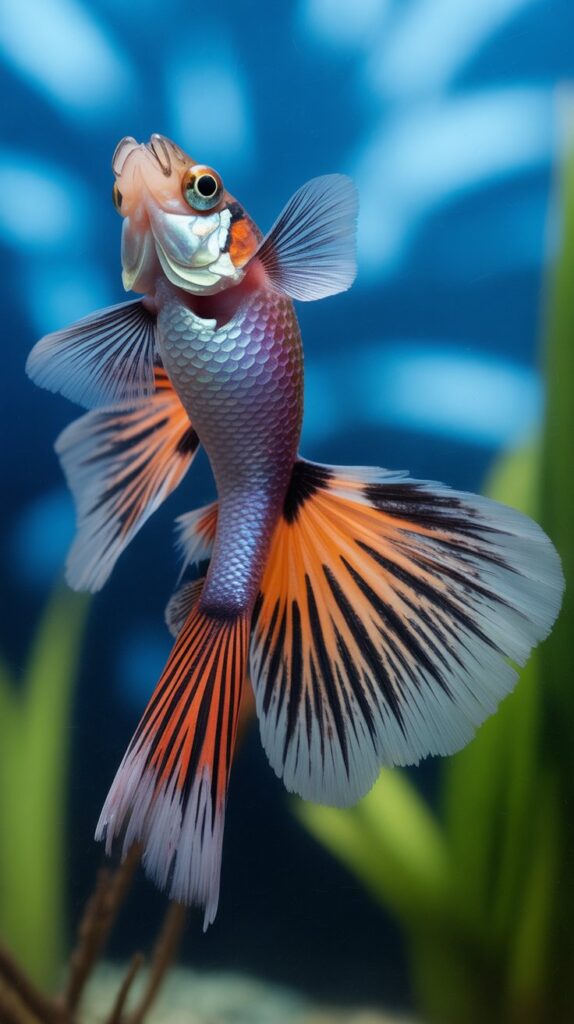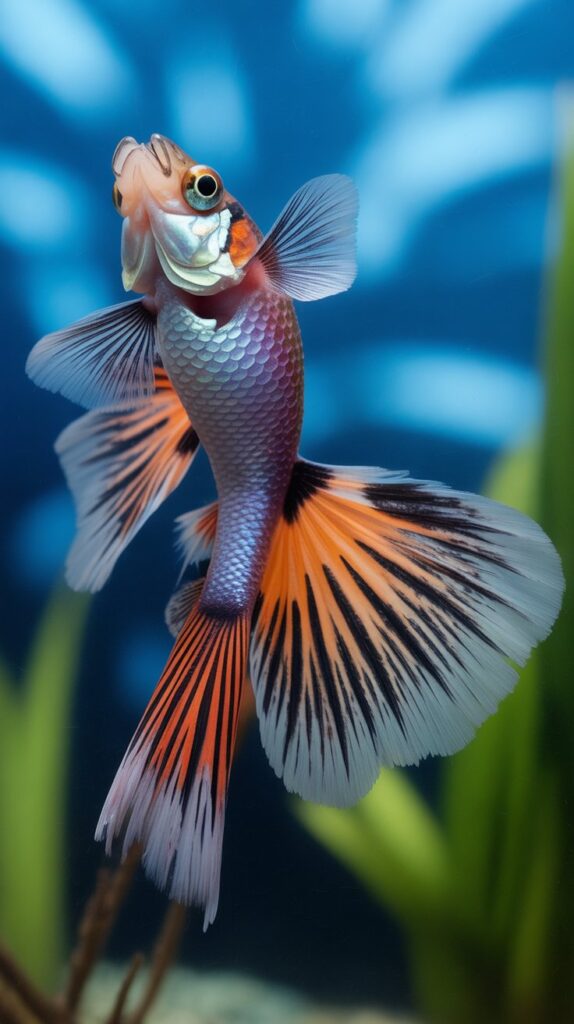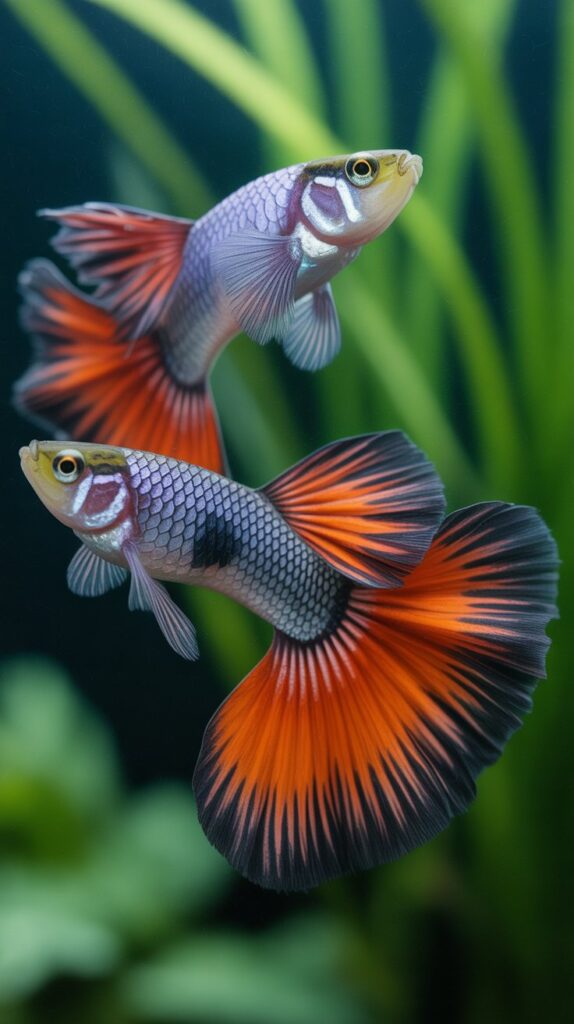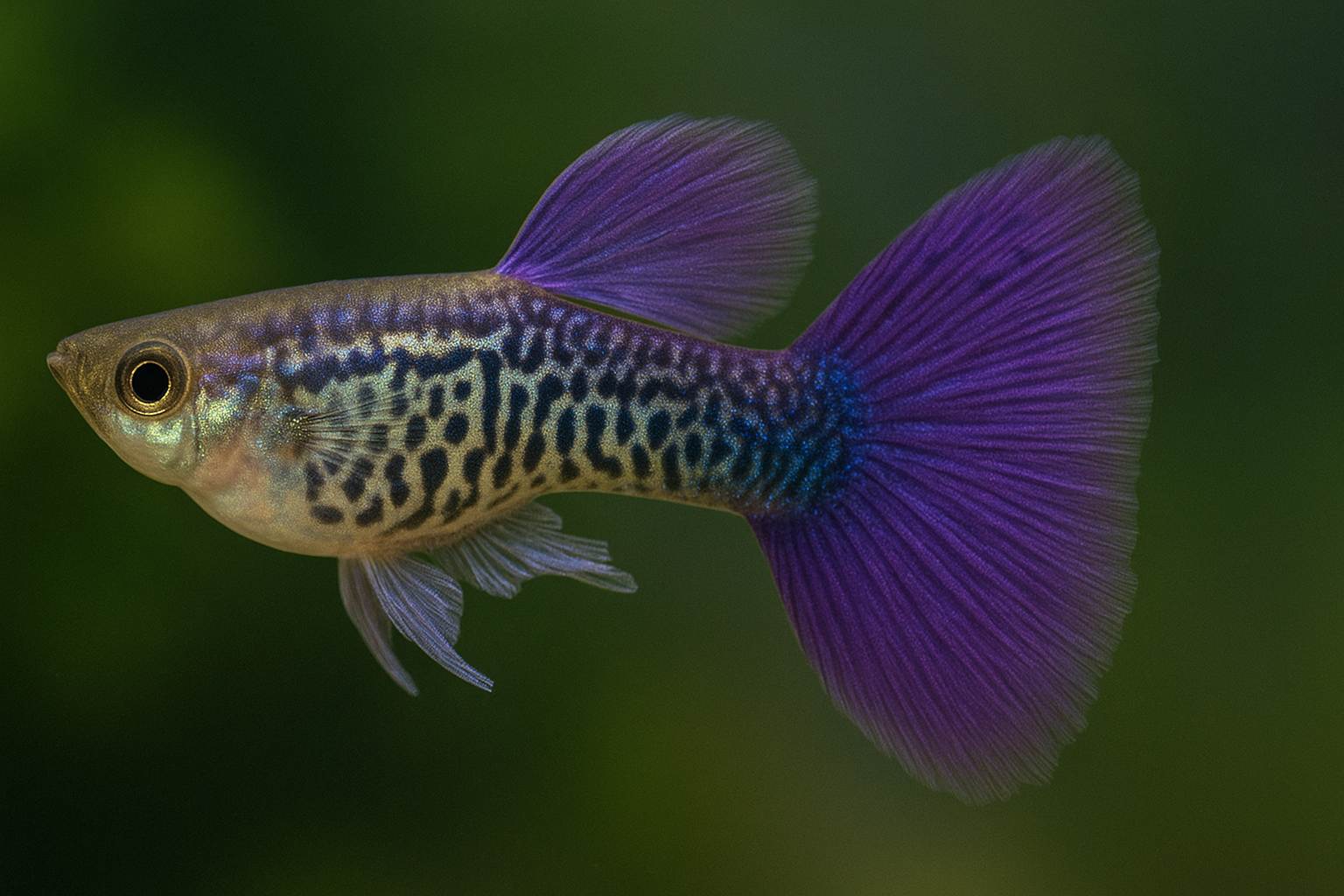The Purple Snakeskin Guppy is one of the most visually captivating varieties of guppy fish, combining the mesmerizing snakeskin pattern with a rich, vibrant purple hue. Known for its intricate body markings, long flowing fins, and peaceful temperament, this guppy is a favorite among aquarium enthusiasts worldwide. It is not only a stunning display fish but also hardy and easy to care for, making it perfect for both beginners and experienced aquarists.
In this complete guide, we’ll explore the Purple Snakeskin Guppy’s origins, appearance, care requirements, diet, breeding, tank mates, health concerns, and tips for keeping them at their brightest and healthiest.
1. Origin and History of the Purple Snakeskin Guppy
The guppy (Poecilia reticulata) originates from South America, specifically from Venezuela, Brazil, Guyana, and Trinidad. Wild guppies were first introduced to Europe in the 1800s, and since then, breeders have developed hundreds of color and fin variations.

The Purple Snakeskin Guppy is a selectively bred ornamental strain that features:
- Snakeskin Pattern – An intricate reticulated (net-like) pattern on the body and sometimes the fins.
- Purple Coloration – A rich lavender-to-deep-violet hue achieved through careful genetic selection.
This variety is the product of generations of crossbreeding, aimed at enhancing both the snakeskin markings and the intensity of the purple color.
2. Physical Appearance
The Purple Snakeskin Guppy stands out due to its striking mix of pattern and color.
Key Features
- Body Color: Shades of purple, ranging from pastel lavender to deep royal violet.
- Pattern: Reticulated snakeskin pattern—thin, interconnected lines resembling scales of a snake.
- Fins: Long, flowing dorsal and caudal fins, often patterned or edged in purple.
- Size:
- Males: 1.5–2 inches
- Females: 2–2.5 inches
- Sexual Dimorphism: Males are more colorful and have elaborate fins, while females are larger with less vibrant colors.
Lighting plays a big role in highlighting the purple tones—LED aquarium lights tend to bring out their best coloration.
3. Behavior and Temperament
Like most guppies, the Purple Snakeskin Guppy is:
- Peaceful: Rarely aggressive; gets along with other small, non-aggressive fish.
- Active: Constant swimmers that explore every corner of the aquarium.
- Social: Thrive in groups; best kept in schools of at least 6 or more.
- Non-territorial: Suitable for community aquariums.
Their calm nature and bright colors make them a great addition to planted or mixed-species tanks.
4. Tank Setup for Purple Snakeskin Guppies

Tank Size
- Minimum: 10 gallons for a small group.
- Recommended: 20 gallons or more for stability and to accommodate breeding.
Water Parameters
- Temperature: 72–82°F (22–28°C)
- pH: 6.8–7.8
- Hardness: 8–12 dGH
- Ammonia & Nitrite: 0 ppm
- Nitrate: Below 20 ppm
Filtration
A sponge filter or gentle hang-on-back filter is ideal—these guppies prefer calm water flow.
Lighting
Moderate LED lighting helps highlight the purple tones and enhances plant growth.
Aquascaping
- Plants: Java moss, Anubias, Hornwort, Water Sprite
- Substrate: Dark-colored gravel or sand to make their colors pop.
- Decor: Driftwood, smooth stones, and caves for variety and shelter.
5. Diet and Feeding for Vibrant Colors
The Purple Snakeskin Guppy is omnivorous and thrives on a balanced diet that promotes both health and vibrant coloration.
Diet Recommendations
- Staple Foods:
- High-quality guppy flakes
- Micro pellets
- Protein Sources:
- Live or frozen brine shrimp
- Daphnia
- Bloodworms
- Mosquito larvae
- Vegetable Matter:
- Spirulina flakes
- Blanched spinach or zucchini
Feeding Schedule
- Feed 2–3 times daily in small portions they can consume within 1–2 minutes.
- Avoid overfeeding to prevent water quality issues.
Tip: Foods rich in carotenoids and spirulina enhance the purple and iridescent colors.
6. Breeding Purple Snakeskin Guppies

Guppies are livebearers, meaning they give birth to live fry rather than laying eggs. The Purple Snakeskin Guppy breeds readily in home aquariums.
Breeding Tank Setup
- Size: 10–15 gallons
- Temperature: 78–80°F
- Plants: Dense vegetation or breeding mops for fry hiding spaces.
- Gentle filtration.
Breeding Process
- Keep a ratio of 1 male to 2–3 females to prevent female stress.
- Males court females by displaying their fins and swimming in quick bursts.
- After mating, females store sperm and can give birth multiple times without further mating.
Gestation
- 21–30 days.
- Each brood can contain 20–50 fry.
Fry Care
- Separate fry from adults or use a breeding box.
- First foods: Infusoria or liquid fry food.
- After a few days: Baby brine shrimp or finely crushed flakes.
7. Compatible Tank Mates

The Purple Snakeskin Guppy thrives with other peaceful fish such as:
- Neon Tetras
- Corydoras catfish
- Harlequin Rasboras
- Mollies
- Platies
- Cherry Shrimp (adults safe; baby shrimp may be eaten)
Avoid aggressive or fin-nipping species like tiger barbs, large cichlids, or bettas.
8. Common Health Issues
While hardy, these guppies can develop common freshwater fish diseases if not properly cared for.
Potential Issues
- Ich (White Spot Disease) – Treat with heat adjustments and anti-parasitic medication.
- Fin Rot – Caused by poor water conditions; treat with antibacterial medication.
- Velvet Disease – Gold-dust-like appearance; treat with copper-based medications.
- Swim Bladder Disorder – Often diet-related; feed fiber-rich foods.
Prevention Tips
- Perform weekly water changes (25–30%).
- Quarantine new fish.
- Maintain stable water parameters.
- Avoid overstocking.
9. Tips for Enhancing Color and Longevity
- Keep stress levels low by avoiding aggressive tank mates.
- Provide a nutrient-rich diet with live foods and spirulina.
- Use a darker substrate to increase color contrast.
- Maintain high water quality with consistent tank maintenance.
- Ensure proper lighting for both fish and plants.
10. Why Choose the Purple Snakeskin Guppy?
- Visually Stunning: Unique snakeskin pattern and vivid purple hue.
- Beginner-Friendly: Hardy, adaptable, and easy to care for.
- Active and Social: Brings life and movement to aquariums.
- Prolific Breeders: Great choice for hobbyists interested in guppy genetics.
- Unique Variety: Each fish has slightly different markings.
Conclusion
The Purple Snakeskin Guppy is a dazzling fish variety that combines elegance, vibrant coloration, and fascinating patterns. With proper care, a balanced diet, and a suitable tank environment, they can thrive for years while adding unmatched beauty to your aquarium.
Whether you’re a beginner looking for your first guppy variety or a seasoned aquarist aiming to add something truly striking to your collection, the Purple Snakeskin Guppy is a perfect choice.
FAQs – Purple Snakeskin Guppy
Q1: How long do Purple Snakeskin Guppies live?
A: With proper care, they typically live 2–3 years, sometimes longer.
Q2: Do they require a heater?
A: Yes, especially if the water temperature drops below 72°F.
Q3: Can I breed them with other guppy varieties?
A: Yes, but the offspring may have mixed colors and patterns.
Q4: How many should I keep together?
A: Keep at least 6 guppies to ensure they feel comfortable.
Q5: What is the ideal male-to-female ratio?
A: 1 male to 2–3 females to reduce female stress.
Q6: Do they need live plants in the tank?
A: Live plants are not essential but are highly recommended for shelter and aesthetics.
Q7: How can I enhance their purple color?
A: Feed foods rich in spirulina and carotenoids, maintain clean water, and provide good lighting.

